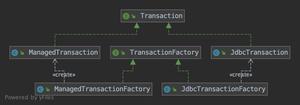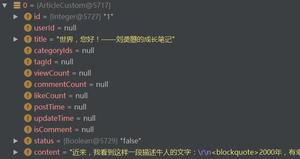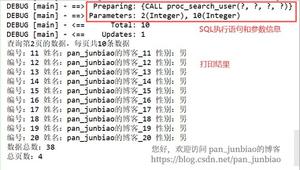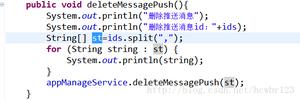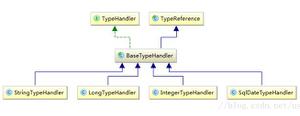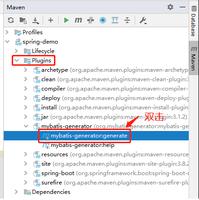Mybatis之方法如何映射到XML

前言
上文Mybatis之Mapper接口如何执行SQL中了解到,Mapper通过动态代理的方式执行SQL,但是并没有详细的介绍方法是如何做映射的,方法包括:方法名,返回值,参数等;这些都是如何同xxMapper.xml进行关联的。
方法名映射
上文中提到缓存MapperMethod的目的是因为需要实例化SqlCommand和MethodSignature两个类,而这两个类实例化需要花费一些时间;而方法名的映射就在实例化SqlCommand的时候,具体可以看构造方法:
private final String name; private final SqlCommandType type;
public SqlCommand(Configuration configuration, Class<?> mapperInterface, Method method) {
final String methodName = method.getName();
final Class<?> declaringClass = method.getDeclaringClass();
MappedStatement ms = resolveMappedStatement(mapperInterface, methodName, declaringClass,
configuration);
if (ms == null) {
if (method.getAnnotation(Flush.class) != null) {
name = null;
type = SqlCommandType.FLUSH;
} else {
throw new BindingException("Invalid bound statement (not found): "
+ mapperInterface.getName() + "." + methodName);
}
} else {
name = ms.getId();
type = ms.getSqlCommandType();
if (type == SqlCommandType.UNKNOWN) {
throw new BindingException("Unknown execution method for: " + name);
}
}
}
首先获取了方法的名称和定义此方法的类,一般此类都是xxxMapper类;注此处的declaringClass类和mapperInterface是有区别的,主要是因为此方法可以是父类里面的方法,而mapperInterface是子类;所以如果定义了父xxxMapper,同样也能进行映射,所以可以看相关代码:
private MappedStatement resolveMappedStatement(Class<?> mapperInterface, String methodName, Class<?> declaringClass, Configuration configuration) {
String statementId = mapperInterface.getName() + "." + methodName;
if (configuration.hasStatement(statementId)) {
return configuration.getMappedStatement(statementId);
} else if (mapperInterface.equals(declaringClass)) {
return null;
}
for (Class<?> superInterface : mapperInterface.getInterfaces()) {
if (declaringClass.isAssignableFrom(superInterface)) {
MappedStatement ms = resolveMappedStatement(superInterface, methodName,
declaringClass, configuration);
if (ms != null) {
return ms;
}
}
}
return null;
}
}
可以看到方法名映射的时候并不是只有名称,同样在前面加了接口名称类似:com
.xx.mapper.XXMapper+方法名,其对应的就是xxMapper.xml中的namespace+statementID;如果可以找到就直接返回configuration中的一个MappedStatement,暂时可以简单为就是xxMapper.xml的一个标签块;如果找不到说明有可能在父类中,可以发现这里使用递归,直到从所有父类中查找,如果还是找不到返回null;
接着上段代码往下看,如果找不到对应的MappedStatement,会查看方法是否有@Flush注解,如果有指定命令类型为FLUSH,否则就抛出异常;找到MappedStatement从里面获取命令类型,所有类型包括:
public enum SqlCommandType { UNKNOWN, INSERT, UPDATE, DELETE, SELECT, FLUSH;
}
INSERT, UPDATE, DELETE, SELECT其实也就是我们在xxMapper.xml中定义的标签;
方法签名
缓存的另一个对象是MethodSignature,直译就是方法签名,包含了方法的返回值,参数等,可以看其构造函数:
public MethodSignature(Configuration configuration, Class<?> mapperInterface, Method method) { Type resolvedReturnType = TypeParameterResolver.resolveReturnType(method, mapperInterface);
if (resolvedReturnType instanceof Class<?>) {
this.returnType = (Class<?>) resolvedReturnType;
} else if (resolvedReturnType instanceof ParameterizedType) {
this.returnType = (Class<?>) ((ParameterizedType) resolvedReturnType).getRawType();
} else {
this.returnType = method.getReturnType();
}
this.returnsVoid = void.class.equals(this.returnType);
this.returnsMany = configuration.getObjectFactory().isCollection(this.returnType) || this.returnType.isArray();
this.returnsCursor = Cursor.class.equals(this.returnType);
this.mapKey = getMapKey(method);
this.returnsMap = this.mapKey != null;
this.rowBoundsIndex = getUniqueParamIndex(method, RowBounds.class);
this.resultHandlerIndex = getUniqueParamIndex(method, ResultHandler.class);
this.paramNameResolver = new ParamNameResolver(configuration, method);
}
首先是获取返回值的类型Type,我们在查询的时候是需要更加具体的类型的,比如是对象类型,基本数据类型,数组类型,列表类型,Map类型,游标类型,void类型;所以这里获取类型的时候需要Type类型的子接口类一共包括:ParameterizedType, TypeVariable<D>, GenericArrayType, WildcardType这四种分别表示:
ParameterizedType:表示一种参数化的类型,比如Collection;
TypeVariable:表示泛型类型如T;
GenericArrayType:类型变量的数组类型;
WildcardType:一种通配符类型表达式,比如?, ? extends Number;
获取到具体类型之后,根据类型创建了四个标识:returnsMany,returnsMap,returnsVoid,returnsCursor,分别表示:
returnsMany:返回列表或者数组;
returnsMap:返回一个Map;
returnsVoid:没有返回值;
returnsCursor:返回一个游标;
除了以上介绍的几个参数,还定义了三个参数分别是:RowBounds在所有参数中的位置,ResultHandler参数在所有参数中的位置,以及实例化了一个参数解析类ParamNameResolver用来作为参数转为sql命令参数;注:RowBounds和ResultHandler是两个特殊的参数,并不映射到xxMapper.xml中的参数,分别用来处理分页和对结果进行再处理;
参数映射处理
参数的映射处理主要在ParamNameResolver中处理的,在实例化MethodSignature的同时,初始化了一个ParamNameResolver,构造函数如下:
private final SortedMap<Integer, String> names;private boolean hasParamAnnotation;
public ParamNameResolver(Configuration config, Method method) {
final Class<?>[] paramTypes = method.getParameterTypes();
final Annotation[][] paramAnnotations = method.getParameterAnnotations();
final SortedMap<Integer, String> map = new TreeMap<Integer, String>();
int paramCount = paramAnnotations.length;
// get names from @Param annotations
for (int paramIndex = 0; paramIndex < paramCount; paramIndex++) {
if (isSpecialParameter(paramTypes[paramIndex])) {
// skip special parameters
continue;
}
String name = null;
for (Annotation annotation : paramAnnotations[paramIndex]) {
if (annotation instanceof Param) {
hasParamAnnotation = true;
name = ((Param) annotation).value();
break;
}
}
if (name == null) {
// @Param was not specified.
if (config.isUseActualParamName()) {
name = getActualParamName(method, paramIndex);
}
if (name == null) {
// use the parameter index as the name ("0", "1", ...)
// gcode issue #71
name = String.valueOf(map.size());
}
}
map.put(paramIndex, name);
}
names = Collections.unmodifiableSortedMap(map);
}
首先获取了参数的类型,然后获取参数的注解;接下来遍历注解,在遍历的过程中会检查参数类型是否是RowBounds和ResultHandler,这两个类型前文说过,是两个特殊的类型并不用于参数映射,所以这里过滤掉了,然后获取注解中的值如@Param("id")中的value="id",如果没有注解值,会检查mybatis-config.xml中是否配置了useActualParamName,这是一个开关表示是否使用真实的参数名称,默认为开启,如果关闭了开关则使用下标0,1,2...来表示名称;下面已一个例子来说明一下,比如有如下方法:
public Blog selectBlog3(@Param("id") long id, @Param("author") String author);那对应的names为:{0=id, 1=author},如果去掉@Param,如下:
public Blog selectBlog3(long id, String author);对应的names为:{0=arg0, 1=arg1},如果关闭useActualParamName开关:
<setting name="useActualParamName" value="false"/>对应的names为:{0=0, 1=1};names这里只是初始化信息,真正和xxMapper.xml中映射的参数还在ParamNameResolver中的另一个方法中做的处理:
public Object getNamedParams(Object[] args) { final int paramCount = names.size();
if (args == null || paramCount == 0) {
return null;
} else if (!hasParamAnnotation && paramCount == 1) {
return args[names.firstKey()];
} else {
final Map<String, Object> param = new ParamMap<Object>();
int i = 0;
for (Map.Entry<Integer, String> entry : names.entrySet()) {
param.put(entry.getValue(), args[entry.getKey()]);
// add generic param names (param1, param2, ...)
final String genericParamName = GENERIC_NAME_PREFIX + String.valueOf(i + 1);
// ensure not to overwrite parameter named with @Param
if (!names.containsValue(genericParamName)) {
param.put(genericParamName, args[entry.getKey()]);
}
i++;
}
return param;
}
}
此方法会遍历names,在遍历之前会检查是否为空和检查是否只有一个参数,并且没有给这个参数设置注解,那会直接返回这个参数值,并没有key,这种情况xxMapper.xml对应的参数名称其实是不关心的,什么名称都可以直接进行映射;如果不是以上两种情况会遍历names会分别往一个Map中写入两个key值,还是上面的三种情况,经过此方法处理后,值会发生如下变化:
{author=zhaohui, id=158, param1=158, param2=zhaohui}以上是有设置注解名称的情况;
{arg1=zhaohui, arg0=158, param1=158, param2=zhaohui}以上是没有设置注解名称的情况,但是开启了useActualParamName开关;
{0=158, 1=zhaohui, param1=158, param2=zhaohui}以上是没有设置注解名称的情况,并且关闭了useActualParamName开关;
有了以上三种情况,所以我们在xxMapper.xml也会有不同的配置方式,下面根据以上三种情况看看在xxMapper.xml中如何配置:
第一种情况,xxMapper.xml可以这样配置:
<select id="selectBlog3" parameterType="hashmap" resultType="blog"> select * from blog where id = #{id} and author=#{author}
</select>
<select id="selectBlog3" parameterType="hashmap" resultType="blog">
select * from blog where id = #{param1} and author=#{param2}
</select>
第二种情况,xxMapper.xml可以这样配置:
<select id="selectBlog3" parameterType="hashmap" resultType="blog"> select * from blog where id = #{arg0} and author=#{arg1}
</select>
<select id="selectBlog3" parameterType="hashmap" resultType="blog">
select * from blog where id = #{param1} and author=#{param2}
</select>
第三种情况,xxMapper.xml可以这样配置:
<select id="selectBlog3" parameterType="hashmap" resultType="blog"> select * from blog where id = #{0} and author=#{1}
</select>
<select id="selectBlog3" parameterType="hashmap" resultType="blog">
select * from blog where id = #{param1} and author=#{param2}
</select>
正是因为Mybatis在初始化参数映射的时候提供了多种key值,更加方便开发者灵活的设置值;虽然提供了多个key值选择,但个人认为还是设置明确的注解更加规范;
总结
本文重点介绍了SqlCommand和MethodSignature这两个类的实例化过程,SqlCommand重点介绍了方法名的映射通过接口路径+方法名的方式和xxMapper.xml中的namespace+statementID进行映射,并且将到了递归父类的问题;然后就是方法签名,通过方法的返回值类型创建了四个标识;最后讲了参数的映射问题,Mybatis给开发者提供了多样的映射key。
示例代码地址
Github
以上是 Mybatis之方法如何映射到XML 的全部内容, 来源链接: utcz.com/z/510567.html


